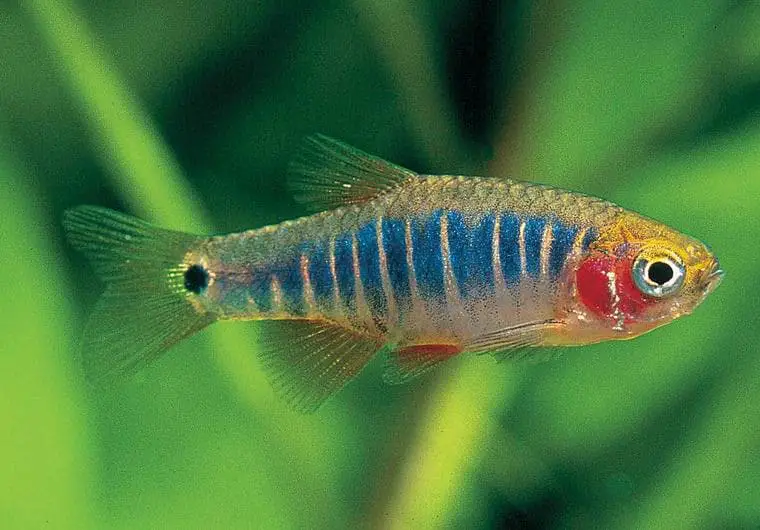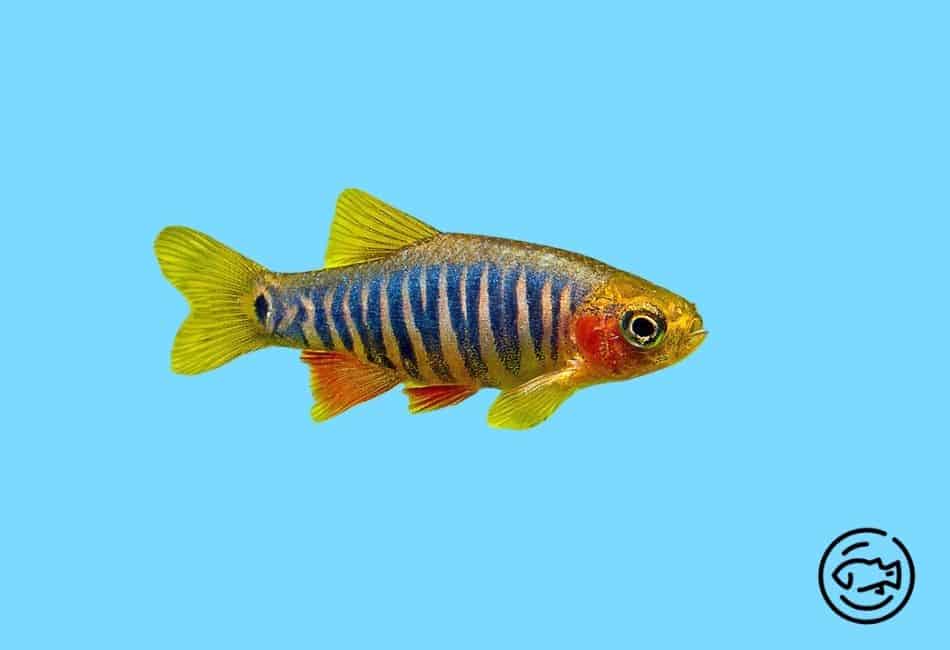Emerald Dwarf Rasboras are beautiful freshwater fish that many people don’t know about. For whatever reason, they just aren’t as popular in the aquarium hobby as other species of fish which is unfortunate because these little guys deserve so much more attention!
Watching them swim around your tank can be very relaxing to watch, and their easy-going nature makes them perfect for beginners who want an enjoyable experience with minimal effort on their part.
However, if you’re interested in owning some yourself and would like information on how best to care for this underrated creature, then keep reading – we’ve got everything covered from feeding requirements to breeding habits here in this Emerald Dwarf Rasbora Care Guide.
Overview
Emerald Dwarf Rasbora looks like little jewels with their bright colors. However, these tiny fish are so small; you might think they’re just algae!
They can be found in the clear and shallow waters of Myanmar’s Lake Inle region, where rapid changes threaten wild populations.
Luckily for these beautiful creatures, Emerald Dwarf Rasboras love to breed, which means there is always a healthy number available at your local pet store or aquarium supplier near you.
You won’t find more exquisite fish than these Rasboras. They’re so small that they can be added to tanks of any size, and their color will brighten even the darkest corners.
Average Emerald Dwarf Rasbora Size
If you’re looking for a fish that’s on the smaller side, look no further!
The average adult Emerald Dwarf Rasbora is between 1 and 1.5 inches in length.
These freshwater fish are perfect for nano tanks because they need very little space to thrive.
They don’t even get bigger than half an inch when they start out as young fry!
In addition, they have steady growth rates, so it won’t be too long before your tank has some full-grown rasboras swimming around among their teeny tiny counterparts.
Lifespan
The lifespan of an Emerald Dwarf Rasbora is around three to five years. This life expectancy for such small fish has proven quite reasonable given their delicate nature and their importance on living conditions.
However, they need pristine living conditions in order to stay healthy for that period.
Their small size causes them more predisposed to things like diseases from crowded tanks, so it’s essential for these fish to stay happy in clean water.
Appearance

Emerald Dwarf Rasboras might be small, but they’re still incredibly beautiful and full of hidden detail. While we could explain to you how it is, you really need to see them in person to appreciate its beauty.
These fish have slender bodies with large eyes and shimmering scales around the gill plate.
They come in colors ranging from coral pink through orange and will often show off these bright colors against dark backgrounds like plants.
Emerald Dwarf Rasboras are a stunning variety of fish with green stripes that shimmer in the light, creating an appealing display. The colors can vary, but most will appear more purple or blue than emerald at some point during their life span.
These fish have a big dot on both sides of the body. And this mimicry helps them with predators while they are in their natural habitat since it can trick them into thinking that it is an eye and will be scared away from attacking.
Emerald Dwarf Rasbora Care
The Emerald Dwarf Rasbora is a fish that can adapt well to many different conditions and will thrive as long as you give it the proper environment.
This species needs stable tank conditions, a nicely decorated habitat with plenty of hiding places, and high-quality food in order to live healthy lives.
When caring for this type of dwarf rasbora, make sure your water stays within its ideal temperature range by making regular changes to its parameters.
Understand and follow the essential care guidelines mentioned below to keep Emerald Dwarf Rasbora in great shape!
Tank Requirements
Emerald Dwarf Rasboras is a dwarf-sized species that needs little room to thrive.
At the very least, keep them in a 10-gallon tank where they can enjoy plenty of space with their tank mates.
However, for even better results, we recommend keeping these fish in 20-gallon tanks as it will provide everyone more swimming area and allow you to fit up to 30 fish into one aquarium!
Water Requirements
The Emerald Dwarf Rasbora is a hardy species that does best in cool, clear waters.
Luckily for them, the home they were born to has crystal-clear lakes and streams from which these fish come.
What makes Lake Inle unique, though?
Well, as it rests 900 meters higher than sea level, cooler temperatures are preferred by this particular type of rasbora – so you must always be on the side of caution when choosing an appropriate water temperature for the tank.
Stick to these water parameters, and your fish will be able to adjust in no time easily:
Water Temperature: 70°F-75°F
pH Levels: 7.0-8.0
Water Hardness: 2 -10dKH
Behavior
Emerald Dwarf Rasbora fish are the friendliest of all freshwater species. They get along well with most other fish, but they prefer to stick together in large groups and do best when surrounded by their own kind.
Emerald Dwarf Rasbora are interesting little fish. They prefer to stay in groups and swim together, but sometimes they like to take a break from the group for their own time.
These fish are as curious about the world around them, which is why they will zigzag through plants and explore every nook of your aquarium. They’re very active for the most part, so you can watch them swim throughout your tank all day.
Tank Decoration for Emerald Dwarf Rasbora
Dense plants and a tank full of decorations are what is needed to give the Emerald Dwarf Rasbora peace.
These fish need places to hide, so they use plants, rocks, or other decorations to take shelter from predators in their natural habitat.
If these features aren’t available when kept inside an aquarium (e.g., due to lack of space), it may lead them into more skittish behavior that can be unhealthy for them over time.
Get a healthy combination of live plants to encourage this behavior. You can use any plant that will sustain the natural environment conditions (reference these care guides, so you know what is safe for your species).
Try to get leafy plants and floating ones, as fish will hide among them. However, avoid driftwood or leaves with tannins- if they are not from clear waters, as you must know that the Emerald Dwarf Rasboras come from clean waters; therefore, it’s doubtful that they’ll tolerate much at all.
At the aquarium floor, use a dark-colored substrate to bring out their color and mimic the loam substrate. Use fine sand instead of gravel as it is more secure for these fish; they prefer staying in large groups with lots of waste. Finally, choose a filtration system with a water flow four or five times more significant than the tank’s volume, as this ensures efficient cycled elimination of any ammonia or nitrates from the water.
Tank Mates
The Emerald Dwarf Rasboras is a peaceful fish that can live in harmony with most other freshwater species. They are not aggressive, but it’s essential to keep them safe by putting plants or rocks between the tank and their food source not to become someone else’s lunch (or dinner).
The best way to avoid any large or aggressive fish is by sticking with smaller ones. Your Rasboras are going to be most comfortable with similar-sized species or fished from the same region of Lake Inle. You can also go for some that come from nearby regions too.
The Dwarf Rasbora is a freshwater fish that enjoys the company of other small schooling species. Sawbwa Barb, Celestial Pearl Danio, and Glowlight Danio are all great tank mates for this tiny little creature!
They enjoy similar water conditions as well, so it’s easy to maintain them in your aquarium. Other good choices include Dario Hysginon or Cherry Shrimp if you’re looking for something larger. Some common snails like Pond Snail can also be found floating around while they eat algae off plants and rocks – just make sure these guys aren’t too big because there may not be enough space left over in the tank.
Potential Diseases
Emerald Dwarf Rasboras are among the most beautiful fish in freshwater tanks, but they can suffer from all of the standard diseases. This includes Ich (a disease that’s usually caused by poor water conditions), parasitic infections, and swim bladder disease.
While it may seem less dangerous than other ailments, such as parasites or fin rot, Ich is a very common yet destructive ailment for Emeralds.
White spots form on its body, which causes discomfort to the animal and could result in death! Unfortunately, it’s also contagious, so keep an eye out as this can rapidly spread everywhere in the aquarium.
Skin flukes are another concern. Flukes latch onto the skin or gills, leading to difficulty breathing and possible death if left untreated.
Swim bladder infection is a significant dangerous thing that these fish experience as bacteria injure their swim bladders – an organ in a fishes’ body that helps them control buoyancy and swimming ability.
Diet
Emerald Dwarf Rasboras are omnivores that can be convinced to eat most commercial flake or pellet foods. These fish come with a passive algae-eating skill, but dry food should still be the primary source of nourishment for them as they will need healthy and well-balanced foods in order to stay happy! You can also study color formulas that bring out the natural vibrancy in Emerald Dwarfs but make sure you do your research first.
Emerald Dwarf Rasboras can be picky sometimes as they usually prefer high-protein snacks more than dry food, but it is essential to occasionally feed them some high-protein snacks.
Providing this enrichment can help keep them healthy and happy. You could try feeding your Emeralds freeze-dried foods like daphnia, bloodworms, or also some baby brine shrimp if you desire to have some variation in their diet.
Breeding
Emerald Dwarf Rasboras love to spawn, and in pristine conditions, will do so without any intervention. They are egg-scatterers but lack parental instincts, which makes things a lot easier for you. If you want the best chance of survival rate with baby Rasboras, breed them under controlled conditions.
Build a separate breeding container or aquarium and fill it with well-cycled water. Next, add spawning mops or leafy plants. Then, add your pair of bonded fish or even groups consisting of two males and multiple females to mix things up.
At this time, you should give high-protein meals to your rasboras, as spawning should happen relatively quickly. Females will produce about 30 eggs throughout the aquarium, and They are going to be mildly adhesive so that the eggs may cling on leaves or decoration items.
Eggs need approximately 72 hours to hatch. Therefore, the fish fry will sustain on the egg sac for an extra three to four days before maturing to free-swimming. After that process of hatching from egg sacs, these little fellows must get fed with Infusoria powder until their ready for Brine Shrimp.
Conclusion
Emerald Dwarf Rasboras are a popular freshwater fish that deserves far more attention from the aquarium community. Their elegance and comfort of care make them an easy decision.
We hope this guide effectively taught you about these fantastic creatures’ needs, temperament, diet, etc. If we didn’t answer your questions thoroughly, please ask us in the comments section below!




You need to be a part of a contest for one of the best websites on the web. I will recommend this blog!